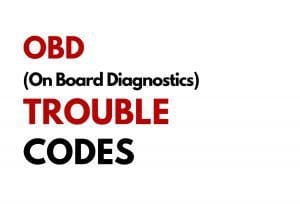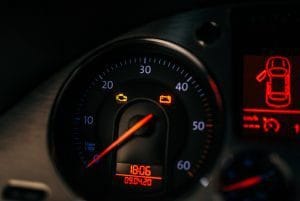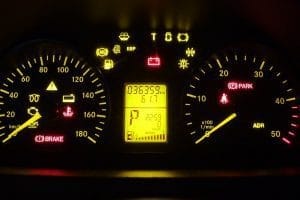A Camshaft is a rotating body in an internal combustion engine, generally made up of cast iron and steel. It operates the opening and closing of intake and exhaust valves with the help of valvetrain.
It transfers rotational motion to reciprocating motion by means of cam lobe to its associated parts which are cam follower, pushrods, rocker arms, valve springs, and tappets.
Working of Camshaft

- They are designed to open the valves at the correct timing and to keep them open for the necessary duration.
- The camshaft is driven by the crankshaft either by using timing gears or timing belts.
- When the camshaft rotates it provides reciprocating motion to cam followers/tappets that operate pushrods (long circular rods) which are attached with rocker arms which then operate valve springs to which valves are coupled.
Camshaft Parts and Function
1- Camshaft centre body
The central body of the cam is made up of cast iron, it is a circular bar on which cam Journals, cam lobe, fuel pump lobe are cast.
2- Cam journals
Cam journals are made up of steel they act as cam support for its rotation where a small layer of lubrication is formed between cam tightening caps and cam journal due to the hydrostatic lubrication system (lubrication by high pressurized pump), which helps in the proper seamless motion of the cam.
3- Camshaft Lobe
The Cam lobe is the most essential part of the camshaft which operates tappets/Cam followers and transfers motion to the rocker arms attached to the valve springs with the help of pushrods.
4- Fuel pump lobe
It is a circular lobe which is used to operate a fuel pump with the help of a belt and pulley system.
5- Camshaft timing gear and locknut
Cam timing gear transfers the power from crank gear to the camshaft, the gear is attached to the rear side of the cam along with the locking nut which helps to keep the gear at its original position.
6- Camshaft position sensor
The function for which camshaft position sensor used are-
- To determine the position and/or rotational speed (RPM) of the cam. Engine Control Units use the information transmitted by the sensor to control parameters such as valve timing and fuel injection timing.
- To increase power and support emissions reduction at the same time.
- For the start of injection during the sequential injection.
- For the actuation signal of the solenoid valve for the pump-nozzle injection system.
- For knocking control.
Camshaft Material
Camshafts are generally made up of two materials cast iron and steel where the center body of the camshaft is Iron cast and the camshafts lobes/cam journals are made up of Steel whereas the material of the cam can vary on the basis of the RPM requirement of a particular engine.
Symptoms of a Bad Camshaft
1- Oil leakage from the cooling plate cover, this occurs due to the following reasons –
- Due to a wrong or cracked cam journal seal fitment.
- Due to excessive ovality present in the camshaft journal which results in the improper fitment of the seal with the journal.
- Due to pitting or dent marks present on the cam journal which allows the path for oil to leak.
2- The abnormal sound coming from the engine when working under normal condition this can be due to-
- Misfitment of cam timing gear with crankshaft timing gear.
- Improper tappet setting.
- Excessive distance between the rocker arm and valve spring which results in delay during valve opening and closing.
- Incorrect Valve Spring Pressure, never install valve springs without verifying the correct assembled height and pressures.
Recommended valve spring pressures are as follows:- Street-type flat tappet cams: 85-100 pounds
- Radical street flat tappet cams: 105-120 pounds
- Street-type hydraulic roller cams: 105-135 pounds
- Mechanical steel roller cams: not more than 150 pounds
3- Sudden Jamming of Camshaft
- It occurs at the initial stage of assembly, this happens due to two reasons-
- Excessive torquing on camshaft tightening caps.
- Oversize or undersize camshaft journal diameter.
4- Sudden stopping of the engine after abnormal crackling sound this occur due to-
Breakage of camshaft, in this a small crack present initially in the shaft during manufacturing or due to mishandling, which elongates in a large crack with time resulting in camshaft sudden breakage and failure.
Camshaft Inspection and Repair
1- Camshaft bend or excessive runout
Inspection- If there is excessive bend then it can be identified by visual inspection but if there is a minor bend then, that can be checked by placing cam on freely rotating rollers at both the ends and placing a dial gauge along with the plunger at the center journal and rotate a camshaft 360 degree this well this will tell us the overall deflection with actual runout or cam bend in microns or mm.
Repair- If there is excessive bend then we have to purchase a new camshaft but if there is a minor bend then it can be repaired by using a bend testing machine, in which both the ends of the camshaft are clamped and a compressive force is applied in the opposite direction of the bend.
Camshaft bend should not exceed the range of 5 to 10 microns.
2- Excessive Ovality in fuel/oil pump lobe and camshaft journals
Inspection- The quality of a cam journal can be checked by using digital for mechanical micrometer by measuring the extreme points in the x-axis and y-axis of the journal dia and the difference in the distance of both the points will tell us the ovality of the journal.
Repair- to repair the ovality in the camshaft sanding belt is used generally of grit size 400.
Ovality should not exceed the range of 7 microns or 0.007mm
3- Scoring lines / Pitting mark / Dent mark and cracks on lobe and Cam Journal
Inspection- It can be checked by visual inspection, remember to clean the surface of a lobe or journal with a lint-free cloth to remove any oil deposits, this will give us a clear image.
Repair- If there is an excessive dent mark or a crack in the camshaft then it must need to be replaced with a new one but if there are minor dent marks or scoring lines then can be removed using sanding belts of 400 grit size.
There is also another method in which the damaged part of the journal is grinded using a pencil grinder and then the grinded part is heated uniformly using a small motor setup, by continuous rotation of cam the distribution of heat is uniform, and then the powdered metal is sprayed by gas welding on the grinded portion and then the excess metal is removed using grinder wheel and finally, at the end it is polished by using sanding belts to bring the dimension of a journal within specification.
4- Incorrect tappet setting
Inspection- If there is an improper tappet setting then-
- During normal engine operation, the abnormal sound will come from the engine.
- No-Go feeler gauge will easily go between the valve stem and rocker arm adjusting screw.
Repair- This fault can be corrected by tappet resetting using a feeler gauge and adjusting screw. During the tappet setting, the feeler gauge needs to be placed between the valve stem and rocker arm, and then the adjusting screw should be tightened.
Note:
The range of feeler gauge while tightening the adjusting screw should exceed 25 to 30 microns at the inlet and 45 to 50 microns at the outlet.
5- A cracked or broken Cam timing gear
Inspection- This can be checked by visual inspection or by looking at the evidence of broken cam gear in the oil sump present at the bottom of the engine.
Repair- In case of broken cam gear we are left with only one option, that is to replace the broken cam gear with the new one.
Note- During the assembly of the cam in the cylinder head remember to check the backlash of the cam after fitment, (the backlash range should not exceed 50 microns, in some engines, it can exceed 80-90 microns but not more than that).
6- Incorrect fitment of Camshaft timing gear
Inspection- If there is an incorrect fitment of camshaft timing gear then the engine will show misfiring and a knocking sound will come from the exhaust and the engine will not be able to reach a certain RPM at a particular acceleration.
Repair- This can be corrected by dismantling of cam gear and resetting it with crankshaft gear, for this the dot presenting on cam gear should be aligned with the mark present on the cylinder head or in some engines the dot on camshaft gear should be aligned with the center of two marks present on crankshaft gear.
Note:
During the adjustment of the mechanical valve, adjust the valve clearance when the lifter is on the base circle of the cam lobe and the piston is at TDC (Top Dead Center)
7- Malfunctioning of CAM position sensor
Inspection- A faulty camshaft sensor can show the following symptoms:
- Difficulty in engine starting
- Engine fault indicator lamp lights up
- It will show error code P0340 in OBD( On-Board Diagnostics)
Repair- Following steps can be followed to troubleshoot cam position sensor-
- Check sensor for damage
- Read out the fault memory
- Check the electrical connections of the sensor wiring, the connector, and the sensor for correct connection, breaks, and corrosion.









